Top Ten Wild Cats
The Top Ten
1 Panther
2 Jaguar
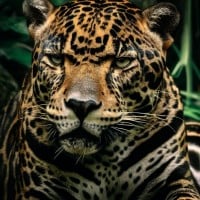 The jaguar (Panthera onca) is a large cat species and the only living member of the genus Panthera native to the Americas. With a body length of up to 1.85 m (6 ft 1 in) and a weight of up to 158 kg (348 lb), it is the largest cat species in the Americas and the third largest in the world. Its distinctively marked coat features pale yellow to tan colored fur covered by spots that transition to rosettes on the sides, although a melanistic black coat appears in some individuals. The jaguar's powerful bite allows it to pierce the carapaces of turtles and tortoises, and to employ an unusual killing method: it bites directly through the skull of mammalian prey between the ears to deliver a fatal ...read more.
The jaguar (Panthera onca) is a large cat species and the only living member of the genus Panthera native to the Americas. With a body length of up to 1.85 m (6 ft 1 in) and a weight of up to 158 kg (348 lb), it is the largest cat species in the Americas and the third largest in the world. Its distinctively marked coat features pale yellow to tan colored fur covered by spots that transition to rosettes on the sides, although a melanistic black coat appears in some individuals. The jaguar's powerful bite allows it to pierce the carapaces of turtles and tortoises, and to employ an unusual killing method: it bites directly through the skull of mammalian prey between the ears to deliver a fatal ...read more.
 The jaguar (Panthera onca) is a large cat species and the only living member of the genus Panthera native to the Americas. With a body length of up to 1.85 m (6 ft 1 in) and a weight of up to 158 kg (348 lb), it is the largest cat species in the Americas and the third largest in the world. Its distinctively marked coat features pale yellow to tan colored fur covered by spots that transition to rosettes on the sides, although a melanistic black coat appears in some individuals. The jaguar's powerful bite allows it to pierce the carapaces of turtles and tortoises, and to employ an unusual killing method: it bites directly through the skull of mammalian prey between the ears to deliver a fatal ...read more.
The jaguar (Panthera onca) is a large cat species and the only living member of the genus Panthera native to the Americas. With a body length of up to 1.85 m (6 ft 1 in) and a weight of up to 158 kg (348 lb), it is the largest cat species in the Americas and the third largest in the world. Its distinctively marked coat features pale yellow to tan colored fur covered by spots that transition to rosettes on the sides, although a melanistic black coat appears in some individuals. The jaguar's powerful bite allows it to pierce the carapaces of turtles and tortoises, and to employ an unusual killing method: it bites directly through the skull of mammalian prey between the ears to deliver a fatal ...read more. Jaguars are the best
3 Caracal
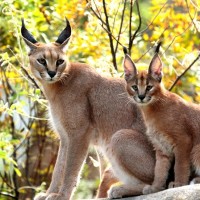 A medium-sized wild cat native to Africa, the Middle East, and parts of Central Asia, the Caracal is known for its agility and leaping ability. It has distinctive long, black-tufted ears and primarily preys on birds, rodents, and small mammals.
A medium-sized wild cat native to Africa, the Middle East, and parts of Central Asia, the Caracal is known for its agility and leaping ability. It has distinctive long, black-tufted ears and primarily preys on birds, rodents, and small mammals.
 A medium-sized wild cat native to Africa, the Middle East, and parts of Central Asia, the Caracal is known for its agility and leaping ability. It has distinctive long, black-tufted ears and primarily preys on birds, rodents, and small mammals.
A medium-sized wild cat native to Africa, the Middle East, and parts of Central Asia, the Caracal is known for its agility and leaping ability. It has distinctive long, black-tufted ears and primarily preys on birds, rodents, and small mammals.
4 Lion
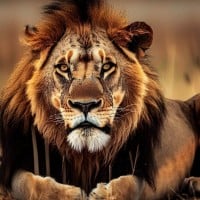 The lion (Panthera leo) is a large cat of the genus Panthera native to Africa and India. It has a muscular, broad-chested body, short, rounded head, round ears, and a hairy tuft at the end of its tail. It is sexually dimorphic; adult male lions are larger than females and have a prominent mane. It is a social species, forming groups called prides. A lion's pride consists of a few adult males, related females, and cubs. Groups of female lions usually hunt together, preying mostly on large ungulates. The lion is an apex and keystone predator; although some lions scavenge when opportunities occur and have been known to hunt humans, the species typically does not actively seek out and prey on humans. ...read more.
The lion (Panthera leo) is a large cat of the genus Panthera native to Africa and India. It has a muscular, broad-chested body, short, rounded head, round ears, and a hairy tuft at the end of its tail. It is sexually dimorphic; adult male lions are larger than females and have a prominent mane. It is a social species, forming groups called prides. A lion's pride consists of a few adult males, related females, and cubs. Groups of female lions usually hunt together, preying mostly on large ungulates. The lion is an apex and keystone predator; although some lions scavenge when opportunities occur and have been known to hunt humans, the species typically does not actively seek out and prey on humans. ...read more.
 The lion (Panthera leo) is a large cat of the genus Panthera native to Africa and India. It has a muscular, broad-chested body, short, rounded head, round ears, and a hairy tuft at the end of its tail. It is sexually dimorphic; adult male lions are larger than females and have a prominent mane. It is a social species, forming groups called prides. A lion's pride consists of a few adult males, related females, and cubs. Groups of female lions usually hunt together, preying mostly on large ungulates. The lion is an apex and keystone predator; although some lions scavenge when opportunities occur and have been known to hunt humans, the species typically does not actively seek out and prey on humans. ...read more.
The lion (Panthera leo) is a large cat of the genus Panthera native to Africa and India. It has a muscular, broad-chested body, short, rounded head, round ears, and a hairy tuft at the end of its tail. It is sexually dimorphic; adult male lions are larger than females and have a prominent mane. It is a social species, forming groups called prides. A lion's pride consists of a few adult males, related females, and cubs. Groups of female lions usually hunt together, preying mostly on large ungulates. The lion is an apex and keystone predator; although some lions scavenge when opportunities occur and have been known to hunt humans, the species typically does not actively seek out and prey on humans. ...read more. The king of the jungle. Make sure to give it raw meat
5 Cheetah
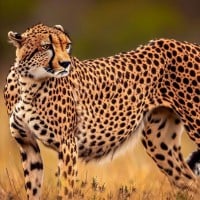 The cheetah (Acinonyx jubatus) is a large cat and native to Africa and central Iran. It is the fastest land animal, estimated to be capable of running at 80 to 128 km/h (50 to 80 mph) with the fastest reliably recorded speeds being 93 and 98 km/h (58 and 61 mph), and as such has several adaptations ...read more.
The cheetah (Acinonyx jubatus) is a large cat and native to Africa and central Iran. It is the fastest land animal, estimated to be capable of running at 80 to 128 km/h (50 to 80 mph) with the fastest reliably recorded speeds being 93 and 98 km/h (58 and 61 mph), and as such has several adaptations ...read more.
 The cheetah (Acinonyx jubatus) is a large cat and native to Africa and central Iran. It is the fastest land animal, estimated to be capable of running at 80 to 128 km/h (50 to 80 mph) with the fastest reliably recorded speeds being 93 and 98 km/h (58 and 61 mph), and as such has several adaptations ...read more.
The cheetah (Acinonyx jubatus) is a large cat and native to Africa and central Iran. It is the fastest land animal, estimated to be capable of running at 80 to 128 km/h (50 to 80 mph) with the fastest reliably recorded speeds being 93 and 98 km/h (58 and 61 mph), and as such has several adaptations ...read more.
6 Tiger
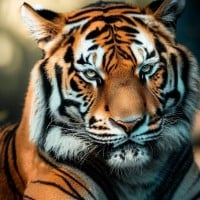 The tiger (Panthera tigris) is the largest living cat species and a member of the genus Panthera. It is most recognisable for its dark vertical stripes on orange fur with a white underside. An apex predator, it primarily preys on ungulates such as deer and wild boar. It is territorial and generally a solitary but social predator, requiring large contiguous areas of habitat, which support its requirements for prey and rearing of its offspring. Tiger cubs stay with their mother for about two years, then become independent and leave their mother's home range to establish their own. ...read more.
The tiger (Panthera tigris) is the largest living cat species and a member of the genus Panthera. It is most recognisable for its dark vertical stripes on orange fur with a white underside. An apex predator, it primarily preys on ungulates such as deer and wild boar. It is territorial and generally a solitary but social predator, requiring large contiguous areas of habitat, which support its requirements for prey and rearing of its offspring. Tiger cubs stay with their mother for about two years, then become independent and leave their mother's home range to establish their own. ...read more.
 The tiger (Panthera tigris) is the largest living cat species and a member of the genus Panthera. It is most recognisable for its dark vertical stripes on orange fur with a white underside. An apex predator, it primarily preys on ungulates such as deer and wild boar. It is territorial and generally a solitary but social predator, requiring large contiguous areas of habitat, which support its requirements for prey and rearing of its offspring. Tiger cubs stay with their mother for about two years, then become independent and leave their mother's home range to establish their own. ...read more.
The tiger (Panthera tigris) is the largest living cat species and a member of the genus Panthera. It is most recognisable for its dark vertical stripes on orange fur with a white underside. An apex predator, it primarily preys on ungulates such as deer and wild boar. It is territorial and generally a solitary but social predator, requiring large contiguous areas of habitat, which support its requirements for prey and rearing of its offspring. Tiger cubs stay with their mother for about two years, then become independent and leave their mother's home range to establish their own. ...read more.
7 Leopard
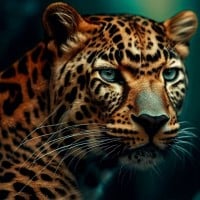 The leopard is one of the five "big cats" in the genus Panthera. It is one of the most adaptable and the most widespread big cat; it's secrets being:well camouflaged fur; its opportunistic hunting behaviour, broad diet, and strength to move heavy carcasses into trees; its ability to adapt to various ...read more.
The leopard is one of the five "big cats" in the genus Panthera. It is one of the most adaptable and the most widespread big cat; it's secrets being:well camouflaged fur; its opportunistic hunting behaviour, broad diet, and strength to move heavy carcasses into trees; its ability to adapt to various ...read more.
 The leopard is one of the five "big cats" in the genus Panthera. It is one of the most adaptable and the most widespread big cat; it's secrets being:well camouflaged fur; its opportunistic hunting behaviour, broad diet, and strength to move heavy carcasses into trees; its ability to adapt to various ...read more.
The leopard is one of the five "big cats" in the genus Panthera. It is one of the most adaptable and the most widespread big cat; it's secrets being:well camouflaged fur; its opportunistic hunting behaviour, broad diet, and strength to move heavy carcasses into trees; its ability to adapt to various ...read more.
8 Lynx
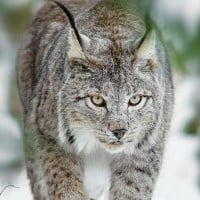 A lynx is any of the four species (the Canada lynx, Iberian lynx, Eurasian lynx, or bobcat) within the medium-sized wild cat genus Lynx. The name lynx originated in Middle English via Latin from the Greek word λύγξ, derived from the Indo-European root leuk- ('light, brightness') in reference to ...read more.
A lynx is any of the four species (the Canada lynx, Iberian lynx, Eurasian lynx, or bobcat) within the medium-sized wild cat genus Lynx. The name lynx originated in Middle English via Latin from the Greek word λύγξ, derived from the Indo-European root leuk- ('light, brightness') in reference to ...read more.
 A lynx is any of the four species (the Canada lynx, Iberian lynx, Eurasian lynx, or bobcat) within the medium-sized wild cat genus Lynx. The name lynx originated in Middle English via Latin from the Greek word λύγξ, derived from the Indo-European root leuk- ('light, brightness') in reference to ...read more.
A lynx is any of the four species (the Canada lynx, Iberian lynx, Eurasian lynx, or bobcat) within the medium-sized wild cat genus Lynx. The name lynx originated in Middle English via Latin from the Greek word λύγξ, derived from the Indo-European root leuk- ('light, brightness') in reference to ...read more.
9 Snow Leopard
 The snow leopard (Panthera uncia), also known as the ounce, is a felid in the genus Panthera native to the mountain ranges of Central and South Asia. It is listed as Vulnerable on the IUCN Red List because the global population is estimated to number fewer than 10,000 mature individuals and is expected to decline about 10% by 2040. It is threatened by poaching and habitat destruction following infrastructural developments. It inhabits alpine and subalpine zones at elevations of 3,000–4,500 m (9,800–14,800 ft), ranging from eastern Afghanistan, the Himalayas and the Tibetan Plateau to southern Siberia, Mongolia and western China. In the northern part of its range, it also lives at lower elevations. ...read more.
The snow leopard (Panthera uncia), also known as the ounce, is a felid in the genus Panthera native to the mountain ranges of Central and South Asia. It is listed as Vulnerable on the IUCN Red List because the global population is estimated to number fewer than 10,000 mature individuals and is expected to decline about 10% by 2040. It is threatened by poaching and habitat destruction following infrastructural developments. It inhabits alpine and subalpine zones at elevations of 3,000–4,500 m (9,800–14,800 ft), ranging from eastern Afghanistan, the Himalayas and the Tibetan Plateau to southern Siberia, Mongolia and western China. In the northern part of its range, it also lives at lower elevations. ...read more.
 The snow leopard (Panthera uncia), also known as the ounce, is a felid in the genus Panthera native to the mountain ranges of Central and South Asia. It is listed as Vulnerable on the IUCN Red List because the global population is estimated to number fewer than 10,000 mature individuals and is expected to decline about 10% by 2040. It is threatened by poaching and habitat destruction following infrastructural developments. It inhabits alpine and subalpine zones at elevations of 3,000–4,500 m (9,800–14,800 ft), ranging from eastern Afghanistan, the Himalayas and the Tibetan Plateau to southern Siberia, Mongolia and western China. In the northern part of its range, it also lives at lower elevations. ...read more.
The snow leopard (Panthera uncia), also known as the ounce, is a felid in the genus Panthera native to the mountain ranges of Central and South Asia. It is listed as Vulnerable on the IUCN Red List because the global population is estimated to number fewer than 10,000 mature individuals and is expected to decline about 10% by 2040. It is threatened by poaching and habitat destruction following infrastructural developments. It inhabits alpine and subalpine zones at elevations of 3,000–4,500 m (9,800–14,800 ft), ranging from eastern Afghanistan, the Himalayas and the Tibetan Plateau to southern Siberia, Mongolia and western China. In the northern part of its range, it also lives at lower elevations. ...read more. I love the snow leopard!
10 Fishing Cat
The Contenders
11 Cougar
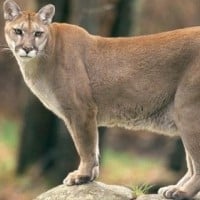 The cougar, also commonly known as the mountain lion, puma, panther, or catamount, is a large felid of the subfamily Felinae native to the Americas.
The cougar, also commonly known as the mountain lion, puma, panther, or catamount, is a large felid of the subfamily Felinae native to the Americas.
 The cougar, also commonly known as the mountain lion, puma, panther, or catamount, is a large felid of the subfamily Felinae native to the Americas.
The cougar, also commonly known as the mountain lion, puma, panther, or catamount, is a large felid of the subfamily Felinae native to the Americas.
12 Sand Cat
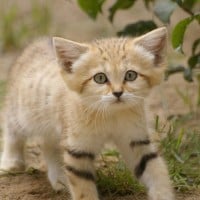 The sand cat (Felis margarita), also known as the sand dune cat, is the only cat living chiefly in true deserts. This small cat is widely distributed in the deserts of North Africa, the Middle East and Central Asia. Starting in 2002, it was listed as near threatened on the IUCN Red List because the ...read more.
The sand cat (Felis margarita), also known as the sand dune cat, is the only cat living chiefly in true deserts. This small cat is widely distributed in the deserts of North Africa, the Middle East and Central Asia. Starting in 2002, it was listed as near threatened on the IUCN Red List because the ...read more.
 The sand cat (Felis margarita), also known as the sand dune cat, is the only cat living chiefly in true deserts. This small cat is widely distributed in the deserts of North Africa, the Middle East and Central Asia. Starting in 2002, it was listed as near threatened on the IUCN Red List because the ...read more.
The sand cat (Felis margarita), also known as the sand dune cat, is the only cat living chiefly in true deserts. This small cat is widely distributed in the deserts of North Africa, the Middle East and Central Asia. Starting in 2002, it was listed as near threatened on the IUCN Red List because the ...read more.
13 Flat-Headed Cat
14 Ocelot
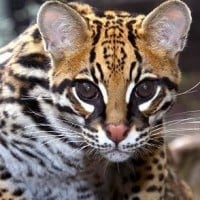 The ocelot, also known as the dwarf leopard, is a wild cat distributed extensively within South America including the islands of Trinidad and Margarita, Central America, and Mexico. It has been reported as far north as Texas.
The ocelot, also known as the dwarf leopard, is a wild cat distributed extensively within South America including the islands of Trinidad and Margarita, Central America, and Mexico. It has been reported as far north as Texas.
 The ocelot, also known as the dwarf leopard, is a wild cat distributed extensively within South America including the islands of Trinidad and Margarita, Central America, and Mexico. It has been reported as far north as Texas.
The ocelot, also known as the dwarf leopard, is a wild cat distributed extensively within South America including the islands of Trinidad and Margarita, Central America, and Mexico. It has been reported as far north as Texas.
15 Margay
16 Rusty Spotted Cat
17 Andean Mountain Cat
18 Serval
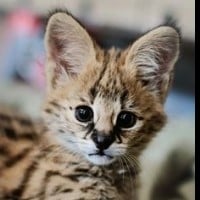 The serval is a medium-sized wild cat native to Africa. It is recognized for its distinctive coat, featuring a tawny background with bold black spots and stripes. Servals have a slender body, long legs, and large ears with excellent hearing capabilities. They are adapted to a semi-aquatic lifestyle, often found near wetlands or marshes. Servals are skilled hunters, preying on a variety of small animals like rodents, birds, and amphibians. They are known for their unique hunting technique of leaping into the air to catch birds in flight. Despite their striking appearance, servals are elusive creatures that are rarely seen in the wild.
The serval is a medium-sized wild cat native to Africa. It is recognized for its distinctive coat, featuring a tawny background with bold black spots and stripes. Servals have a slender body, long legs, and large ears with excellent hearing capabilities. They are adapted to a semi-aquatic lifestyle, often found near wetlands or marshes. Servals are skilled hunters, preying on a variety of small animals like rodents, birds, and amphibians. They are known for their unique hunting technique of leaping into the air to catch birds in flight. Despite their striking appearance, servals are elusive creatures that are rarely seen in the wild.
 The serval is a medium-sized wild cat native to Africa. It is recognized for its distinctive coat, featuring a tawny background with bold black spots and stripes. Servals have a slender body, long legs, and large ears with excellent hearing capabilities. They are adapted to a semi-aquatic lifestyle, often found near wetlands or marshes. Servals are skilled hunters, preying on a variety of small animals like rodents, birds, and amphibians. They are known for their unique hunting technique of leaping into the air to catch birds in flight. Despite their striking appearance, servals are elusive creatures that are rarely seen in the wild.
The serval is a medium-sized wild cat native to Africa. It is recognized for its distinctive coat, featuring a tawny background with bold black spots and stripes. Servals have a slender body, long legs, and large ears with excellent hearing capabilities. They are adapted to a semi-aquatic lifestyle, often found near wetlands or marshes. Servals are skilled hunters, preying on a variety of small animals like rodents, birds, and amphibians. They are known for their unique hunting technique of leaping into the air to catch birds in flight. Despite their striking appearance, servals are elusive creatures that are rarely seen in the wild.
19 Bobcat
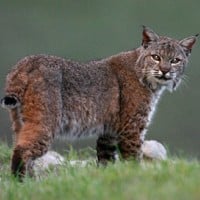 The bobcat is a North American cat that appeared during the Irvingtonian stage of around 1.8 million years ago.
The bobcat is a North American cat that appeared during the Irvingtonian stage of around 1.8 million years ago.
 The bobcat is a North American cat that appeared during the Irvingtonian stage of around 1.8 million years ago.
The bobcat is a North American cat that appeared during the Irvingtonian stage of around 1.8 million years ago.
20 Jaguarundi
21 Wildcat
22 Pallas's Cat
23 Leopard Cat
24 African Golden Cat
25 Chinese Mountain Cat
8Load More
PSearch List